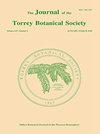Vegetation response to large scale disturbance in a southern Appalachian forest: Hurricane Opal and salvage logging
IF 0.8
4区 生物学
Q4 PLANT SCIENCES
引用次数: 77
Abstract
such as catastrophic windthrow can play a major role in the structure and composition of southern Appalachian forests. We report effects of Hurricane Opal followed by salvage logging on vegetation dynamics (regeneration, composition, and diversity) the first three years after disturbance at the Coweeta Hydrologic Laboratory in western North Carolina. The objective of this study was to compare species composition and diversity of understory and groundlayer species in a hurricane + salvage logged (H+S) forest to an adjacent undisturbed forest. Abundance of groundlayer species was much higher in the H+S forest than in the undisturbed forest, and abundance increased over time. Percent cover, density, and species richness were significantly higher in the H+S forest than in the undisturbed forest. In addition, percent cover increased by approximately 85% between 1997 and 1999 in the H+S plots. Shannon's index of diversity (H') based on percent cover was significantly higher in the H+S forest than the undisturbed forest by the third year after disturbance. However, there was no significant difference in H' based on density between H+S forest and the undisturbed forest in either year. In the undisturbed forest, 59 species and 50 genera represented 30 families. By 1999 (the third year after disturbance), the H+S forest retained 93 species, 72 genera and 42 families. The Asteraceae and Liliaceae had the highest number of species in both sampled forests, with more species of Liliaceae in the H+S plots. Micro-relief created from pit and mound topography from uprooting of windthrown trees, shade from the slash-debris left on site from the salvage logging, and shade from the remaining overstory trees created a mosaic of environmental conditions. This environmental heterogeneity could be responsible for the mix of early (shade intolerant) and late (shade tolerant) successional herbaceous species, and a higher species richness and diversity than the undisturbed forest.南阿巴拉契亚森林植被对大尺度扰动的响应:飓风蛋白石和采伐
比如灾难性的风阻,可以在阿巴拉契亚南部森林的结构和组成中发挥重要作用。本文报道了北卡罗莱纳州西部Coweeta水文实验室遭受飓风“Opal”干扰后的头三年,对植被动态(再生、组成和多样性)的影响。本研究的目的是比较飓风+救助采伐(H+S)森林与相邻未受干扰森林的林下物种和底层物种的组成和多样性。土壤H+S林的底土层物种丰度明显高于未受干扰林,且丰度随时间的增加而增加。H+S森林的盖度、密度和物种丰富度均显著高于未受干扰的森林。此外,在1997 - 1999年间,H+S样地的覆盖率增加了约85%。干扰发生后第3年,H+S森林基于盖度的Shannon多样性指数显著高于未受干扰的森林。但在不同年份,H+S林与未受干扰林的密度H′值差异不显著。原始林有30科50属59种。到1999年(干扰后第三年),H+S林保留了42科72属93种。两种样地的物种数量均以菊科和百合科最多,H+S样地的百合科物种较多。由于被风吹倒的树木被连根拔起而形成的坑状地形和丘状地形形成了微浮雕,由于打捞性伐木而留下的现场刀伤碎片形成了阴影,剩余的上层树木形成了阴影,创造了马赛克般的环境条件。这种环境异质性可能导致早期(不耐阴)和晚期(耐阴)演替草本物种混合,物种丰富度和多样性高于未受干扰的森林。
本文章由计算机程序翻译,如有差异,请以英文原文为准。
求助全文
约1分钟内获得全文
求助全文
来源期刊
CiteScore
0.70
自引率
0.00%
发文量
16
审稿时长
>12 weeks
期刊介绍:
The Journal of the Torrey Botanical Society (until 1997 the Bulletin of the Torrey Botanical Club), the oldest botanical journal in the Americas, has as its primary goal the dissemination of scientific knowledge about plants (including thallopyhtes and fungi). It publishes basic research in all areas of plant biology, except horticulture, with an emphasis on research done in, and about plants of, the Western Hemisphere.

 求助内容:
求助内容: 应助结果提醒方式:
应助结果提醒方式:


